 Fifth Media have announced the forthcoming unveiling of their AXIA A308 PDA Phone, proudly proclaimed as the (deep breath), “world’s smallest PDA Phone on Microsoft Windows Mobile 5 featuring Wi-Fi connectivity.”
Fifth Media have announced the forthcoming unveiling of their AXIA A308 PDA Phone, proudly proclaimed as the (deep breath), “world’s smallest PDA Phone on Microsoft Windows Mobile 5 featuring Wi-Fi connectivity.”
Due to be seen at the CeBIT exhibition in Hannover next month, the quad-band AXIA A308 packs in GSM, GPRS and EDGE connectivity – as well as the all-important Wi-Fi connectivity – into its diminutive proportions.
Running on Microsoft Windows Mobile 5.0, the pocket-rocket PDA also offers Bluetooth and IrDA-enabled connectivity, with the whole caboodle measuring just 20.8 x 48.8 x 113.3mm and weighing 128g.
Powered by a surprisingly nippy Intel PXA272 CPU 416 MHz processor, the Axia comes with a reasonable 128 MB of flash memory an 64MB of RAM, with a decent sized 2.2″ Transflective TFT LCD 262K colour running at 240 x 320 resolution.
Multimedia is taken care of with WAV/WMA/MP3 support and a basic, built in 1.3 MegaPixel CMOS fixed focus camera. Memory can be expanded via the miniSD flash memory slot.
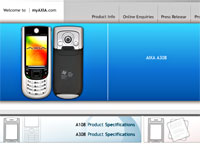 The all-important battery life is claimed at 4 hours talktime with the removable/rechargeable 1500mAh Li-Polymer offering 120 hours of standby time.
The all-important battery life is claimed at 4 hours talktime with the removable/rechargeable 1500mAh Li-Polymer offering 120 hours of standby time.
On the initial specs, this looks like a very attractive phone – we like the ‘proper’ keypad and the fact that they’ve wedged in so much functionality into such a small form.
The built in Wi-Fi is already getting our wallets twitching and with a processor powerful enough to run Skype, we’ll be looking out for this one at CeBIT.
SPECIFICATIONS
PROCESSOR Intel PXA272 CPU 416 MHz
MEMORY Flash 128MB; RAM 64MB
DISPLAY 2.2″ Transflective TFT LCD 262K colour with 240 x 320 resolution White LED Touch Screen
AUDIO Microphone Loudspeaker for speaker function 2.5mm stereo headphone jack Support WAV/WMA/MP3 stereo
CAMERA 1.3 MegaPixel CMOS Fixed focus
BATTERY Removable/rechargeable 1500mAh Li-Polymer
Talktime: 4 hours*
Standby Time: 120 hours*
CONNECTIVITY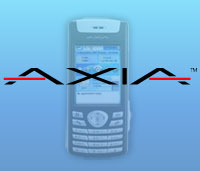 Quad-band GSM (850/900/1800/1900 MHz)
Quad-band GSM (850/900/1800/1900 MHz)
Integrated GSM/GPRS/EDGE
Wireless LAN (IEEE 802.11b compliant)
Bluetooth (1.2 compliant, Class 2 transmit power)
IrDA
OPERATING SYSTEM
Microsoft® Windows® Mobile 5 Pocket PC
OS Microsoft® Pocket Internet Explorer
Windows® Media Player 10
Windows® Messenger
Transcriber software
DIMENSIONS 20.8 (D) X 48.8 (W) X 113.3 (L) mm
WEIGHT 128g
EXPANSION Mini SD slot
 More flexible than a Russian athlete in a vat of oil, Samsung’s double-flipping DMB phone offers a novel twist on the clamshell format.
More flexible than a Russian athlete in a vat of oil, Samsung’s double-flipping DMB phone offers a novel twist on the clamshell format.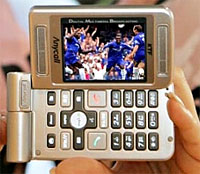 As well as the DMB functionality, the Samsung SPH-B1300 serves up the usual advanced mobile feature set, complete with a two megapixel digital camera and built-in MP3 player.
As well as the DMB functionality, the Samsung SPH-B1300 serves up the usual advanced mobile feature set, complete with a two megapixel digital camera and built-in MP3 player. We can expect more details about the Samsung SPH-B1300 to be revealed at the CeBit 2006 show in Hannover next month.
We can expect more details about the Samsung SPH-B1300 to be revealed at the CeBit 2006 show in Hannover next month.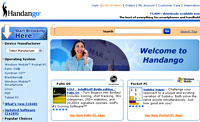 Handango has released their annual “Handango Yardstick”, a global snapshot of the state of the mobile content industry in 2005.
Handango has released their annual “Handango Yardstick”, a global snapshot of the state of the mobile content industry in 2005.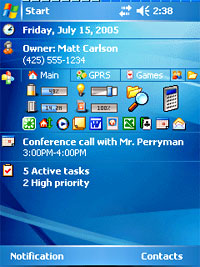 New additions included the Motorola RAZR V3, the BlackBerry 7100 Series and the BlackBerry 7250/7290 (the first BlackBerry smartphone to ever make the top ten).
New additions included the Motorola RAZR V3, the BlackBerry 7100 Series and the BlackBerry 7250/7290 (the first BlackBerry smartphone to ever make the top ten).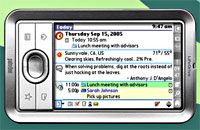 The top ten Windows Mobile Pocket PC applications were:
The top ten Windows Mobile Pocket PC applications were: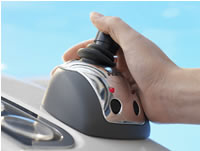 When it comes to Friday, our thoughts are drawn to life on the sea with the inevitable weekend sojourn to Monte Carlo (doesn’t everyone weekend there?).
When it comes to Friday, our thoughts are drawn to life on the sea with the inevitable weekend sojourn to Monte Carlo (doesn’t everyone weekend there?). The latest innovation from Volvo Penta is bound to add extra ammunition to the yacht-owners dislike of Motor boats and their owners. It looks like it makes it a doodle of maneuver a boat, with almost super-human skills.
The latest innovation from Volvo Penta is bound to add extra ammunition to the yacht-owners dislike of Motor boats and their owners. It looks like it makes it a doodle of maneuver a boat, with almost super-human skills.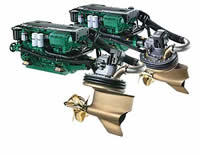 They’ve taken the idea beyond simple X-Y joystick movements to incorporate a twisting action and a couple of buttons. X-Y provides the obvious forward/backward, plus an interesting side-to-side action, which doesn’t swing the boat around, but literally slides it sideways – neat.
They’ve taken the idea beyond simple X-Y joystick movements to incorporate a twisting action and a couple of buttons. X-Y provides the obvious forward/backward, plus an interesting side-to-side action, which doesn’t swing the boat around, but literally slides it sideways – neat. The joystick’s twisting action rotates the boat, seemingly on a six-pence, in either direction, right or left – again, most impressive.
The joystick’s twisting action rotates the boat, seemingly on a six-pence, in either direction, right or left – again, most impressive.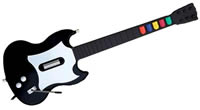 It’s rare that there are inconsistencies in the Digital-Lifestyles clan, but there’s one subject that brings a split consensus. Some of us, me included, think that different forms of controllers for video game is a trend that is just starting – a more natural way of working with the games console is inevitable, like the
It’s rare that there are inconsistencies in the Digital-Lifestyles clan, but there’s one subject that brings a split consensus. Some of us, me included, think that different forms of controllers for video game is a trend that is just starting – a more natural way of working with the games console is inevitable, like the  Rock-power-fiends will set their fingers a flyin’ around the five frets, strum-bar and whammy bar. Beyond the buttons, there’s an alignment sensor used to gain extra style points when it’s played vertically. Expect the inducement of dizziness as heads are thrown around in a frenzy.
Rock-power-fiends will set their fingers a flyin’ around the five frets, strum-bar and whammy bar. Beyond the buttons, there’s an alignment sensor used to gain extra style points when it’s played vertically. Expect the inducement of dizziness as heads are thrown around in a frenzy. With the Multiplayer mode seeing two players facing-off in what are described as ‘an electrifying series of guitar duels’, it’s quite unclear what will happen over artistic differences, or even usages of the power axe (otherwise known as guitar) as there’s only one shipped with the software.
With the Multiplayer mode seeing two players facing-off in what are described as ‘an electrifying series of guitar duels’, it’s quite unclear what will happen over artistic differences, or even usages of the power axe (otherwise known as guitar) as there’s only one shipped with the software. Initial previews have been strong and it’s gained from PR boosts with the like The Darkness talking about on MTV Overdrive. It looks like there’s high hopes from this one.
Initial previews have been strong and it’s gained from PR boosts with the like The Darkness talking about on MTV Overdrive. It looks like there’s high hopes from this one.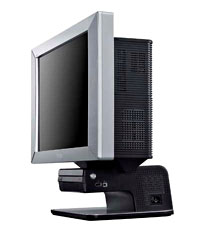 Sony has announced the new VAIO VA1 Series, a wireless home entertainment desktop computer.
Sony has announced the new VAIO VA1 Series, a wireless home entertainment desktop computer.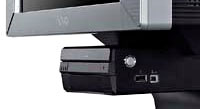 High definition audio is provided by Sony’s Direct Stream Digital (DSD), a technology developed by Sony in conjunction with Philips.
High definition audio is provided by Sony’s Direct Stream Digital (DSD), a technology developed by Sony in conjunction with Philips.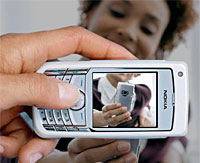 Although cameras are considered to be an essential part of modern mobile phones, a new study has revealed that only a tiny percentage of camera phone snaps are actually being stored or sent.
Although cameras are considered to be an essential part of modern mobile phones, a new study has revealed that only a tiny percentage of camera phone snaps are actually being stored or sent. “However, once they start using their new phones, they are turned off by perceived poor picture quality, slow network speeds, and the difficulty of creating and sending pictures. Our survey found that very few pictures actually make their way out of the handset to be shared with others,” he commented.
“However, once they start using their new phones, they are turned off by perceived poor picture quality, slow network speeds, and the difficulty of creating and sending pictures. Our survey found that very few pictures actually make their way out of the handset to be shared with others,” he commented. After seeing the dire quality of the pictures taken with our
After seeing the dire quality of the pictures taken with our  Consumers wanting to be able to take and send decent quality photos are hit by a double whammy: camera phones capable of taking high quality phones aren’t cheap, and the higher resolution files they create end up costing a bomb in network carrier costs. Best solution? Take along a ‘real’ camera and email it when you get home.
Consumers wanting to be able to take and send decent quality photos are hit by a double whammy: camera phones capable of taking high quality phones aren’t cheap, and the higher resolution files they create end up costing a bomb in network carrier costs. Best solution? Take along a ‘real’ camera and email it when you get home.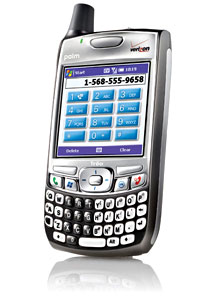 It’s been spluttering and wheezing in its sick bed for what seems like an eternity, but the latest figures from research firm IDC confirm that the prognosis isn’t good for the Personal Digital Assistant (PDA).
It’s been spluttering and wheezing in its sick bed for what seems like an eternity, but the latest figures from research firm IDC confirm that the prognosis isn’t good for the Personal Digital Assistant (PDA).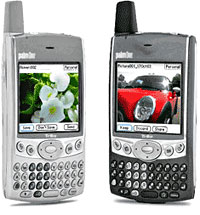 Although a bright Christmas period saw sales grow 37.6% over Q3, the trend remains resolutely downward, with the declining market segment driving PDAs into a market niche.
Although a bright Christmas period saw sales grow 37.6% over Q3, the trend remains resolutely downward, with the declining market segment driving PDAs into a market niche.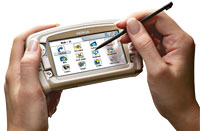 But don’t go ordering flowers for the PDA funeral quite yet, as IDC research analyst Ramon Llamas insists that it’s not all over for the PDA market, with plenty of smaller vendors remaining committed to a more niche PDA market.
But don’t go ordering flowers for the PDA funeral quite yet, as IDC research analyst Ramon Llamas insists that it’s not all over for the PDA market, with plenty of smaller vendors remaining committed to a more niche PDA market.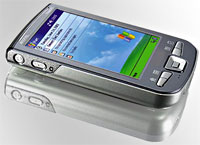 With Palm winding down its PDA business and concentrating on its Treo smartphone range, Nelson argues that Palm will have difficulty competing against deep-pocketed rivals like Dell and HP who are currently ploughing big R&D budgets into similar products.
With Palm winding down its PDA business and concentrating on its Treo smartphone range, Nelson argues that Palm will have difficulty competing against deep-pocketed rivals like Dell and HP who are currently ploughing big R&D budgets into similar products. They’ve been bustier than Jock McHasty in a rush at i-mate, as the PDA/smartphone vendor releases another addition to their range, the i-mate PDA-N – the company’s first GPS PDA.
They’ve been bustier than Jock McHasty in a rush at i-mate, as the PDA/smartphone vendor releases another addition to their range, the i-mate PDA-N – the company’s first GPS PDA.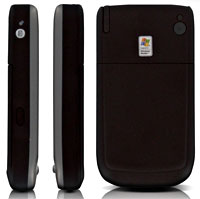 The front of the slim device is dominated by a 2.83″ 240×320 pixels transmissive TFT-LCD screen supporting 64k colours, with a row of four buttons and a joystick below.
The front of the slim device is dominated by a 2.83″ 240×320 pixels transmissive TFT-LCD screen supporting 64k colours, with a row of four buttons and a joystick below.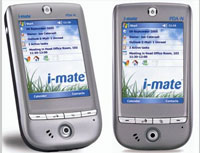 According to I-mate, the PDA-N notches up a rated battery life of 5 hours in GPS mode and 8 hours playing a looped video.
According to I-mate, the PDA-N notches up a rated battery life of 5 hours in GPS mode and 8 hours playing a looped video.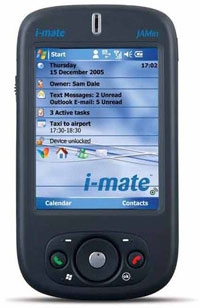 A week ahead of its scheduled launch, smartphone bigwigs i-mate have revealed details of their latest model, the JAMin.
A week ahead of its scheduled launch, smartphone bigwigs i-mate have revealed details of their latest model, the JAMin.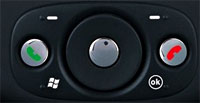 Switching from a 416 MHz Intel processor to a 200 MHz TI processor (we know it sounds like it must be slower but they’re not directly comparable), i-mate have stuck with the JAM form factor, adding a different button layout and twice the ROM.
Switching from a 416 MHz Intel processor to a 200 MHz TI processor (we know it sounds like it must be slower but they’re not directly comparable), i-mate have stuck with the JAM form factor, adding a different button layout and twice the ROM. Also known as the HTC Prophet (and O2 XDA Neo), the phone shouldn’t stir it up in the pocket department, measuring a compact 10.8 x 5.8 x 1.8cm and weighing 150g. Memory expansion is taken care of courtesy of a SD IO slot
Also known as the HTC Prophet (and O2 XDA Neo), the phone shouldn’t stir it up in the pocket department, measuring a compact 10.8 x 5.8 x 1.8cm and weighing 150g. Memory expansion is taken care of courtesy of a SD IO slot